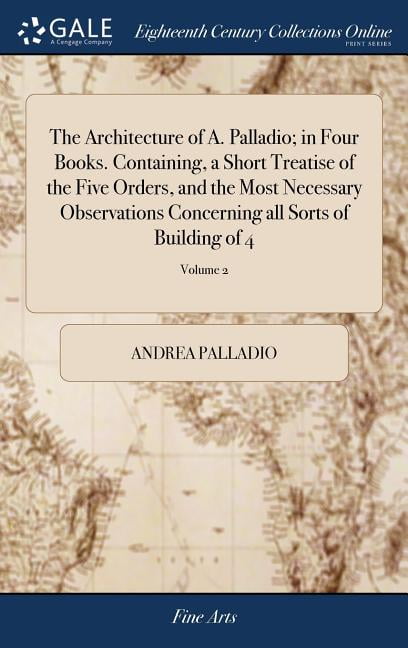
It contains the standard guide to historical sights, with the contemporary commentary by Palladio, but also an example of one of the indulgences which many pilgrims would have purchased during their visit. Andrea Palladio (15081580) was one of the most celebrated architects of the Renaissance, so important that the term Palladian has been applied to a.

The book as a package nicely wraps up the pilgrim's experience of Rome. The indulgence was issued by Bernhardino Cirillo, the Archibishop of Loreto, to raise money for additions to the hospital at Santo Spirito in Saxia.
:max_bytes(150000):strip_icc()/Palladian-533470670-crop-57e8aab15f9b586c35db18c9.jpg)
The binder used some scrap paper from the shop: left over printed indulgences. 'In all my villas, and in some town houses, I have mounted the gable onto the front facade, where the main doors are, so that these gables may indicate the entrances of the house and serve the greatness and splendour of the work by raising the front part of a. The act of writing it surely helped Palladio define his views of architecture and develop his architectural principles that would come to dominate the era.īound with the Palladio is an Italian translation of Mirabilia Romae also printed in 1565. The Four Books of Architecture: Second Book, Chapter XIII. architectural treatise by the famed Italian architect Andrea Palladio. I had a problem with my payment once, and it took them like 5 mins to solve it. The Four Books of Architecture Palladio, Andrea, Ware, Isaac on. It tells the history of Roman buildings and guides the readers to notice certain features. Their Support is real people, Four Books Of ArchitectureAndrea Palladio and they are always friendly and supportive. We recently acquired an important precursor, Palladio’s L’antichita di Roma (Venice, 1565). Of even greater significance than Palladio's buildings is his. WHEN: The 16th century Italian architect Andrea Palladio, one of the great masters of Renaissance culture, has had an enduring influence on American architecture. It brought the theories of the Roman architect Vitruvius into the modern world, reshaped Renaissance architecture and profoundly influenced neo-classicism. ANDREA PALLADIO (1508-1580) Four Books on Architecture. In the Fourth Book, Palladio reproduces the designs of a number of ancient. L.4058-1961.Andrea Palladio is best known for his 1570 I qvattro libri dell'archiettvra, or Four Books of Architecture. The Third Book is concerned with streets, bridges, piazzas, and basilicas, most of which are of ancient Roman origin. Wansted House, plate from Vitruvius Britannicus or, The British architect, Vol. 1 Biography 2 Palladian architecture 3 Palladios architecture 4 The Palladian window 5 Early Palladianism 6 English Palladian revival (neo-Palladian) 7. These four books greatly contributed to Palladian revival architecture. The Renaissance architect Andrea Palladio was one of the most influential figures that the field of architecture has ever produced.

Above all, the composition relied for its effect on the careful balance between the blank, untextured wall surface and the window openings, giving it a sense of combined grandeur and repose. The Palladian, Serlian, or Venetian window features largely in Palladios work. The Four Books on Architecture Andrea Palladio 1997. His architecture was based on symmetry, proportion, and his own codification of the Classical Orders. It also featured a rusticated basement – a lower floor which contained masonry blocks with a rough, rustic appearance that contrasted with the smooth finish of the building at a higher level. Palladio re-interpreted Roman architecture for contemporary use and published his ideas in 'I Quattro Libri dell’Architettura' (The Four Books of Architecture, 1570), which was translated and re-published across Europe.
#Andrea palladio four books of architecture window windows#
It featured a design for his pioneering house at Wanstead, Essex, which incorporated all the key Palladian features: a focus on symmetry, proportion and balance, with one side of the building a mirror image of the other the use of temple fronts (a pediment supported by Corinthian columns or pilasters) and large tripartite Venetian windows. The First Book Of Architecture By Andrea Palladio Translated Out Of Italian With An Appendix Touching Doors And Windows By Pr Le Muet Translated Illustrated With Above Seventy Copper CutsAndrea Palladio, A Gaelic primer containing rules for pronouncing the language with numerous examples also a copious vocabulary arranged under distinct heads a list of primitive and derivative pronouns the. He is also known for his book Treatise I Quattro Libri Dell’Architettura (which translates to The Four Books of Architecture) (ibid). His book Vitruvius Britannicus, or The British Architect (1715) was a catalogue of contemporary British buildings. Palladio was known for his palace designs (palazzi) and villas, particularly the Villa Rotonda, which was built in 1551 near Vicenza (ibid). Palladianism first emerged in Britain in the work of the Scottish architect Colen Campbell (1676 – 1729).


 0 kommentar(er)
0 kommentar(er)
